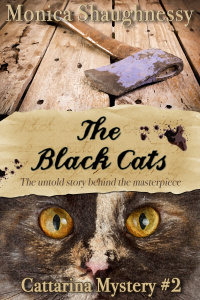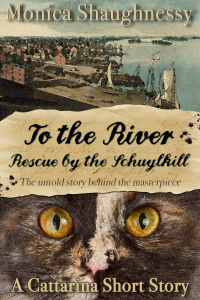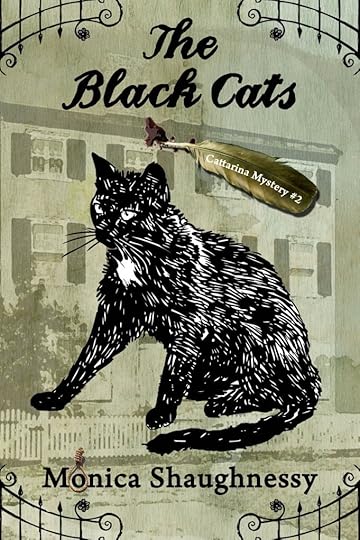Monica Shaughnessy's Blog, page 4
February 13, 2015
The 99 Cent Valentine
 Is anyone else outraged by the price of greeting��cards?��They’re made of��paper, for heaven’s sake, and printed with��crummy��poems and photos of kittens wearing cupid wings…and someone will��THROW THEM AWAY two days later. So I ask you:
Is anyone else outraged by the price of greeting��cards?��They’re made of��paper, for heaven’s sake, and printed with��crummy��poems and photos of kittens wearing cupid wings…and someone will��THROW THEM AWAY two days later. So I ask you:
WHY DO CARDS��COST $4.99? And more importantly, why do we continue to send��them?
Sure, I have a few that��people gave me over the years (just to prove they cared). But the majority I receive go right into the recycling bin. Yes, even the ones my husband gives me on Valentine’s Day. I’m not heartless. It’s just that I’m already burdened with too much stuff, and I’m running out of places to keep it. (Hey, empty mayonnaise jars and scrap lumber may come in handy one day.)��Besides the wasted money, there’s the wasted resources on assembling, printing, shipping, etc. Between keeping a tree or getting a greeting card, I’ll choose the tree every time.
The alternative is the��e-card. But nothing shows how little you care than sending a link to a dancing bear (really? you shouldn’t have…). That’s why I’d like to propose a new tradition, one that won’t put you in the poorhouse if you’ve got a big mailing list:
This Valentine’s Day,��send an ebook instead of card.
If you think about it, this is a pretty progressive (if not brilliant) idea. Consider the following:
Ebooks cost less than most greeting cards (especially when you consider postage)
Novels and short stories took the��author a lot longer to craft than a lousy kitten poem – and your recipient will enjoy them longer.
If you choose the right ebook for the right person, it feels more personal than a dancing bear.
This unconventional “Valentine” has staying power – most people keep ebooks for months, if not years.
You can send them last minute – like today or tomorrow.
Ebooks are a green choice.
So how does it work? Simply go to Amazon, browse until you find a fab book, then click on the “Give as a Gift” link (right under the 1-Click button). From there, enter your recipient’s email address, type in a heart-felt note, and hit send.
 You can start right here, with my book, The Tell-Tail Heart. (You knew this was coming, didn’t you?) For a limited time, it’s on sale for 99 cents. (FYI: This is the second of four February offers.) Send it off to��cat lovers, Edgar Allan Poe lovers, mystery lovers, historical lovers…well, any lovers. :-) It’s been hailed by reviewers as “original” and “unique” and “a fun read.”
You can start right here, with my book, The Tell-Tail Heart. (You knew this was coming, didn’t you?) For a limited time, it’s on sale for 99 cents. (FYI: This is the second of four February offers.) Send it off to��cat lovers, Edgar Allan Poe lovers, mystery lovers, historical lovers…well, any lovers. :-) It’s been hailed by reviewers as “original” and “unique” and “a fun read.”
Don’t fancy a mystery? How about��Rumi: The Book of Love, a collection of love poems from the famous mystic. It’s only $3.99!
Or for kids, Pete the Cat: Valentine’s Day is Cool. It’s only $2.99!
So be a sweetheart and ditch the greeting cards this year.��Give them something they’ll treasure for weeks and months to come.
———————————->
Dear Reader: Lest I be accused of not offering a balanced view of Valentine’s Day cards, I submit this post by my dear friend, Ellen Rothberg. She LOVES greeting cards.

February 4, 2015
“Great Beginnings” Editing Special – 5 pages for $10
 Since February is��the month of��amore, I thought I’d��show some love for writers and readers by running a special every week for the next four weeks. I hope you’ll��check back from time to time and see what’s happening.
Since February is��the month of��amore, I thought I’d��show some love for writers and readers by running a special every week for the next four weeks. I hope you’ll��check back from time to time and see what’s happening.
Week One – (now until Feb. 8th*) – Great Beginnings
Just like romantic relationships, stories��should begin��with��an enticing promise of what’s to come. But too many times, a writer starts in the wrong place or begins with a scene that fails��to illuminate the character’s dilemma or just plain goofs the genre. A��break-up with the reader is inevitable! And don’t think you’re off the hook with non-fiction. You still have to win the reader in your first few pages.��Enter the developmental editor…
For just $10, I’ll read your opening (five pages and a brief 100 word plot��synopsis) and evaluate whether or not you’ve fulfilled your��promise to the reader. This won’t be a line or content edit, mind you, but a high-level look at the effectiveness of your��opening scene.
If you’re interested,��drop me a line (find my contact info here) and let’s discuss your project. I’ll usually be able to turn these around in a day or two. And everything is through PayPal (no checks please!).
* If I get bombarded by editing requests, I reserve the right to shorten my offer timeframe or limit the number of manuscripts I accept. If that happens, I’ll update the page to reflect this.

January 26, 2015
New Covers for the Cattarina Series
Just a quick post��to reveal the new covers I’ve been working on for my Cattarina Mystery series titles. I think these convey “historical mystery” a little better than the old ones.
I’d love to know what you think!

January 17, 2015
Choosing and Working With a Ghostwriter
 I’m currently ghostwriting a project for a client and thought I’d share some quick tips on��selecting and working with someone like me. If you’re unfamiliar with the term, Wikipedia defines it as follows: “A��ghostwriter��is a writer who writes books, articles, stories, reports, or other texts that are officially credited to another person.”
I’m currently ghostwriting a project for a client and thought I’d share some quick tips on��selecting and working with someone like me. If you’re unfamiliar with the term, Wikipedia defines it as follows: “A��ghostwriter��is a writer who writes books, articles, stories, reports, or other texts that are officially credited to another person.”
First, let’s look at why you might want to hire a ghostwriter:
1. You have a great idea, but don’t know the first thing about writing a book. You see something in the news that sparks your interest, and you think, “That would make a great book.” But when��you put fingers to keyboard, you learn��how hard it is to organize your��thoughts into a 300 page manuscript with a coherent story line.
2. You have a great idea, but you’re too busy to execute it yourself. Perhaps you’re already writing in another genre and making money there. If you slow down for a side project outside your genre, you might lose money or focus or time. Or all three.
3. You have a great idea, but you’re not proficient within a particular genre. Your book, The Definitive Guide to��Motorcycle Maintenance, is at the top of the charts. But��you really want to��publish the middle grade novel,��The Adventures of Hurley Davidson! Problem is, the��non-fiction voice that served your other project doesn’t��fly with ten-year-olds.
Notice that every sentence starts with: “You have a great idea…”? That’s because the book-to-be really starts with you, the client. Ideally, you should come to the process with a��concept��in mind. Be prepared to give a little, however, during the pre-writing phase.
So how do you choose a ghostwriter?
1. Look at quotes or references from clients. If a writer hesitates to give you this information, look elsewhere.
2. ��If the ghostwriter is published, read through their reviews and see what readers are saying about their work. Chances are, if the public likes the ghostwriter’s��other books, they’ll probably like yours, too, provided the idea��is solid. Good writing can’t save a lousy premise. I can’t stress this enough.
3. Read a sample of their work. This is a no-brainer. The ghostwriter may be very, very talented. But if you don’t like the voice and style of their writing, it’s not a match. Keep looking.
After choosing someone to write your book, what next? Every ghostwriter has his or her own process for beginning a project. But here’s mine:
1.��Project Overview:��I send a questionnaire to the client that uncovers��the heart of what the book is “really about,” who the target audience is, potential length and complexity of the project, etc.��Even if you have these things firmly in mind, be prepared to bend a little. For instance, you might want a ghostwriter to write a young adult novel for you. But to save costs, you ask them to keep the length to��20,000 words. At this point, a good ghostwriter would probably try to persuade you to a longer length��since most young adult books are 50,000 words and up. Anything less would severely hinder market viability and plot complexity. This is where it’s helpful to rely on a pro’s advice. Remember, you hired them for a reason.
2. Plot Overview: Once the overarching goals are discussed, we move on to the plot overview. If you have a general sense of “how you want the story to go,” this is where it’s communicated. The ghostwriter will take all of your plot points and lay them out to make a cohesive and compelling plot line. He or she may also add sub-plots, additional turning points, etc. If you have no pre-conceived story��lines,��that’s okay, too. The ghostwriter is there to help!
3. Chapter Overview: After the high-level plot is agreed upon, we move on to a chapter by chapter outline. This not only saves the writer later headaches, it saves you, the client, the anxiety of not knowing exactly how the project is going to turn out. If there’s anything you don’t like about the story arc, now is the time to change it.
Once all the “pre-writing” activities are completed, we move on to the actual writing. Again, what follows is my process.
1. The Chapter One Test. I write out the entire first chapter and submit it to my client so they can comment on the character’s voice, the style, the tone, etc. Once all kinks are worked out…
2. The Hard��Work��Begins. At long last, writing can begin! This may take anywhere from weeks to months, depending on the complexity of the project.
After the book is finished, now what? Well, you have two options:
1. Keep everything as is. Don’t touch a word. Send it off to a freelance editor for proofing before indie publication (or small press submission), and start looking for a cover artist.
2. Put your own unique stamp on the book. If you’ve been writing a while (and know what you’re doing), you may want to comb through and do a little word smithing to make the work sound more like your own. This is not only��okay, but encouraged. This is YOUR book now. BUT! If you’re just not sure, then leave. it. alone.
If you’ve been thinking about writing a��book in 2015 but the work terrifies or mystifies you, there are plenty of pros who can help you on your path to publication.
——————————>
Questions about ghostwriting or editing? I’d love to answer them! I don’t bite, promise. :-)

January 10, 2015
Eating and Cooking in Victorian America
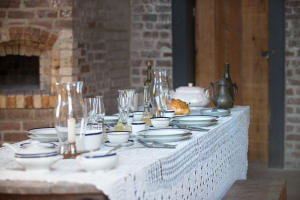 The series I’m working on right now, the Cattarina Mysteries, is set in Victorian Philadelphia.��Because I’m a foodie and an antique cookbook collector, I naturally like to talk about mealtime��in my novels. But��in order to write about food in historical context, research is required. A LOT of research. Here are some of the more interesting things I found out about Victorian foods and preservation methods while tripping through history:
The series I’m working on right now, the Cattarina Mysteries, is set in Victorian Philadelphia.��Because I’m a foodie and an antique cookbook collector, I naturally like to talk about mealtime��in my novels. But��in order to write about food in historical context, research is required. A LOT of research. Here are some of the more interesting things I found out about Victorian foods and preservation methods while tripping through history:
1. Raw tomatoes were thought to be poisonous. During the mid to late 1800s, raw��tomatoes��were still considered unsafe to eat and potentially poisonous. Because of this, recipes of the day usually feature them in a sauce or condiment. Victorians��thought that if you cooked them long enough and diluted them with vinegar and other spices, tomatoes would be safe to eat. Ketchup, anyone?
2. “Refrigeration”��before ice was scary. Before electricity, we had old fashioned “ice boxes.” Men��would carve large blocks of ice from lakes, haul them to town, cover them in sawdust, and bury them or keep them in an ice house. Come summer, the blocks were smaller, but intact, and very dirty since they contained lake sediment. These were then sold to townspeople on ice trucks. Ah! But ice boxes and ice delivery were only just beginning in the 1840s and a family of modest means, a family like Edgar Allan Poe’s, probably wouldn’t have had the money to buy one of these new contraptions and pay for regular ice delivery. So families like these��might have used��something called the “cooling cupboard.” This was a small wooden cabinet��with cut-outs or slats lined with wire mesh (to keep out the flies and rodents). A housewife usually hung or positioned it in the shadiest part of her kitchen. And cellars were an absolute necessity for keeping salted meats, pumpkins, apples, and the like.
3. Fresh eggs could be preserved. Really.��I read about a method of preserving FRESH eggs that involved covering them with lime and submersing them in a bucket of cold water for use MONTHS later. Yuck!
4. Very few things “came in a can.” In the early 1840s,��tinned foods were specialty items. Because cans weren’t massed produced yet, they had to be handmade. One piece of research said that the average tinsmith could produce 100 cans a day. So the early Victorian housewife would still be buying all of her produce fresh (or growing it herself). ��She might, if she had the budget, buy a small tin of oysters, as they were quite popular at the time. There were also many safety concerns about early tin cans, and many people got sick from eating their contents. Aside from the lead they contained, these��cans had a hole in the top (to let steam escape during the boiling process) that was then hand soldered shut. If the seal broke, bacteria thrived.
5. Cheese variety was limited. Sure, Victorians had cheddar since it had been brought over from England a hundred years earlier. But many of the cheeses we enjoy today, like mozzarella, emmentaler, brie, and the like hadn’t even been heard of��by the early��Victorian family, much less sampled. Why? Number one: cheese making was a small, local affair and usually undertaken by a farmer or dairy owner. Mass production��methods weren’t invented until the 1850s. Number two: cheese variety greatly depended upon the immigrants who brought their tastes and techniques with them. Swiss cheese didn’t come to America until some time in the 1830s when Swiss settlers moved to Ohio. So the kind of cheese Victorians ate depended upon the local immigrant population.
6. Before we had cook books, we had “cookery books” filled with receipts. Since a picture is worth a thousand words, I’ll just give you a link to my favorite cookbook. It’s Eliza Leslie’s Directions for Cookery, printed in Philadelphia, 1840. Edgar Allan Poe’s mother in law, Muddy (Maria Clemm), may have used such a book. Check out the recipe for Pepper Pot soup, a very common soup usually sold by African American vendors as a cheap street food. To make it, you start with four pounds of trip and four ox feet… Gulp.
I hope you enjoyed this little snapshot of Victorian food preparation. When you’re eating that can of chili or fresh mozzarella and tomato salad today, think of how far we’ve come!

January 4, 2015
It’s Official! Cats LOVE My Book!

Truffles, Cat Blogger Extraordinaire!
It’s official! 9 out of 10 cats love reading The Black Cats, and the 10th cat is actually a chihuahua with a long tail. If you think this is a totally cute pic–and how could you not?–then check out the full post on Melissa’s Mochas, Mysteries, & Meows.

January 1, 2015
Book Launch: The Black Cats
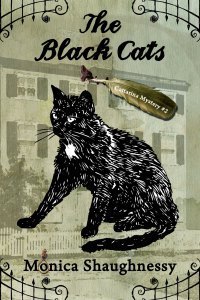 At long last, the follow-up to The Tell Tail Heart has arrived. Just days ago, Jumping Jackalope Press released The Black Cats, Cattarina Mystery #2. I’ve got high hopes for this little book. I’ve already got readers and reviewers lined up and some promotions in the works. At only $2.99 on Amazon, it’s an inexpensive introduction to my writing. Or, if you prefer to start the series from the beginning, The Tell-Tail Heart is on sale right now for only 99 cents (but the price will rise in the next few weeks).
At long last, the follow-up to The Tell Tail Heart has arrived. Just days ago, Jumping Jackalope Press released The Black Cats, Cattarina Mystery #2. I’ve got high hopes for this little book. I’ve already got readers and reviewers lined up and some promotions in the works. At only $2.99 on Amazon, it’s an inexpensive introduction to my writing. Or, if you prefer to start the series from the beginning, The Tell-Tail Heart is on sale right now for only 99 cents (but the price will rise in the next few weeks).
Synopsis:
The untold story behind Edgar Allan Poe’s “The Black Cat.”
Philadelphia, 1843: All is not well in Spring Garden. Fresh from her Glass Eye Killer adventure, Cattarina is once again thrust into mystery when she makes a ghastly discovery – a dead black cat hanging from a tree. Human authorities are uninterested in feline affairs, so Cattarina takes it upon herself to find the culprit.
With the help of her new Green Street Troop and her human companions, she ferrets out the murderer. But her plan to exact justice unleashes a new set of horrors. Now, much more than Eddie’s unfinished story is at stake. If she fails to thwart these events, a dear friend may suffer the black cat’s end.
Full of Victorian wit and rich detail, this cozy novella is a fictional account of Edgar Allan Poe’s real-life animal companion. Fans of historical and animal mysteries are sure to like this series.
———————————>
The next book in the series, The Raven of Liberty, is due out this spring. Gotta love independent publishing!

December 20, 2014
The Christmas Gift That Costs Nothing
 I don’t know what kind of month you’ve had, but mine’s been craaaaaaaazy. Aside from finishing my novella, The Black Cats, putting on a HUGE author event at my local library, and working with an editing client on a new project, I’ve been Christmas shopping. And shopping. And shopping. Bye-bye, bank account. It’s been nice knowing you.
I don’t know what kind of month you’ve had, but mine’s been craaaaaaaazy. Aside from finishing my novella, The Black Cats, putting on a HUGE author event at my local library, and working with an editing client on a new project, I’ve been Christmas shopping. And shopping. And shopping. Bye-bye, bank account. It’s been nice knowing you.
In this season of over-spending giving, we want to shower our friends and loved ones with things. We might even donate money to charity. Why? Because we’ve been taught that it’s better to give than receive. And it is. But what if we re-framed Christmas in broader terms? Why stop at just our close circle of friends and family? Why not extend that charity to everyone you come in contact with between now and December 25th?
I’ll show you how, and it won’t cost you a dime.
Before I tell you, let me backtrack to October. This month, I published a short story called The Trash Collector. I pulled the usual levers and offered it for free. Since then, I’ve given away over 300 copies – not bad for literary fiction about a guy who digs through people’s garbage. While it’s garnered many good reviews, one stands out. Let me say upfront that I’m grateful for all of my reviews – ALL OF THEM. They thrill me (well, except a couple), because they mean someone took the time to do me a favor. But I received a five-star review the other day that really made me think. It was a short review, nothing special, but at the end of it, the reader wrote: Thank You!
Thank you.
With those two words, I felt like the hard work I’d put into the story, the editing I did, the cover I designed, the document I formatted, the files I uploaded, and the low, low price of FREE I offered had all been acknowledged. A tip of the hat. A recognition. This got me thinking. How many times do we consume something in an instant with no real understanding of how long it took to create? Or what it took to create it? Or how many people it took to create it? Here’s an extreme example: when you visit an art museum, you may walk by a Rene Magritte painting and smile – his work brought you joy for a fleeting second. But it took years of dedication to his craft and a whole host of people to recognize and promote his genius just for you to take a quick look at a painting on your way to the museum store.
Aaaaand we’re back to Christmas. (not Thanksgiving, I swear)
Saying “thank you” costs nothing, but gives its receiver the huge bounty of acknowledgement that will likely last longer than crummy jingle bell socks or cheap chocolate Santas or dollar store hand lotion. So I’m vowing that between now and Christmas (and beyond), I will say thank you to people and MEAN IT – restaurant servers, store clerks, piano teachers, mail carriers, authors, family, friends…everyone! And I will start with you, dear reader. THANK YOU for stopping by my blog today. Without your visit, my voice would be but an echo.
So remember, these two words are a small gift, but one you can always afford to give. With any luck, you just might receive them in return.

December 6, 2014
Free Cattarina Short Story!
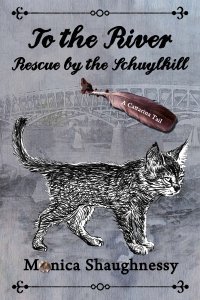 In order to gather more subscribers for my email list, I’m giving away e-copies of my story, “To the River: Rescue by the Schuylkill” when it’s released (some time this month). It’s a short tail about how Eddie and Catters met by the banks of the Philadelphia river.
In order to gather more subscribers for my email list, I’m giving away e-copies of my story, “To the River: Rescue by the Schuylkill” when it’s released (some time this month). It’s a short tail about how Eddie and Catters met by the banks of the Philadelphia river.
All you have to do is go here and follow the directions: SIGN UP @ MAIL CHIMP
Why should you opt-in?
1. You’ll get a short story for FREE.
2. You’ll learn about releases before they hit stores.
3. You’ll have access to secret sales and giveaways.
4. You’ll have my gratitude!

November 26, 2014
Cover Reveal: The Black Cats
Just a quick post to announce that the second book in my Cattarina series will be out in December. The book is done and in the hands of beta readers now. So hopefully, it will be live on Amazon in about a month – less if I can swing it. Fingers crossed!


